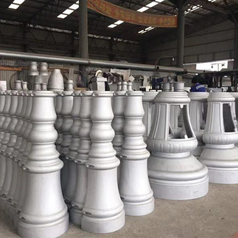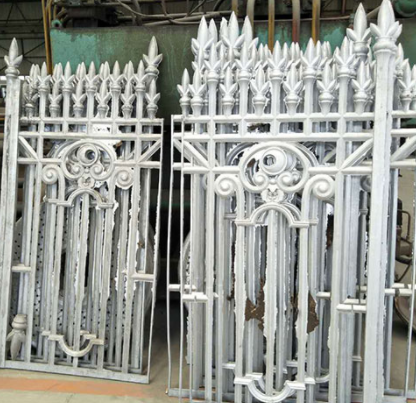Metal casting is a modern process with ancient roots. In the metal casting process, metal shapes are formed by pouring molten metal into a mold cavity, where it is cooled and later extracted from the mold. Metal casting is arguably the earliest and most influential industrial process in history. It's used to make many of the metal objects used in our daily lives: automotive parts, train wheels, lamp posts, school bus pedals, and much more. Plus, metal casting foundries rely on metal recycling as a cost-efficient source of raw material, significantly reducing wasted scrap metal that might end up in landfills.
The oldest known metal casting is that of a copper frog, believed to have been produced in 3200 BCE in Mesopotamia when copper was a popularly used material. Later, around 2000 BCE, iron was discovered. But it was not until around 700 BCE that the first production of cast iron was developed in China. Interestingly enough, the sand molding process of casting metals was also invented in China in 645 BCE.
The crucible process, a technique used for producing fine or tool steel, appeared and disappeared in various locations around the globe since the early 1st millennium CE. The technique popped up in India and central Asia first, until it appeared in northern Europe around 800 CE, where it was used to make Viking swords. The technique didn't resurface until 1750 when Benjamin Huntsman reinvented it in England. Huntsman heated small pieces of carbon steel in a closed crucible, which is a ceramic pot with refractory properties that can withstand a high degree of heat. Huntsman achieved a temperature high enough to melt steel for the first time.
Over the past thousands of years, the casting of metals into usable objects has evolved to become more exact and automated, but the process at its core has essentially remained the same.
Patternmaking – A pattern is a replica of the exterior of the casting. Patterns are typically made of wood, metal, plastic, or plaster. Patternmaking is incredibly important for industrial part-making, where precise calculations are needed to make pieces fit and work together.
Coremaking – If a casting is hollow, an additional piece of sand or metal (called a core) shapes the internal form to make it hollow. Cores are typically strong yet collapsible so they can be easily removed from the finished casting.
Molding – To visualize the metal casting process so far, imagine yourself walking on the beach toward the ocean. Look at a footprint you leave behind in the wet sand. Your foot would be the core, and the impression left in the sand is a mold of your foot. Molding is a multistep process that will form a cast around the pattern using molding sand. In casting, a mold is contained in a frame called a flask. Green sand, or molding sand, is packed into the flask around the pattern. This is known as metal sand casting. Once the sand is packed tight, the pattern can be removed and the cast will remain. Alternatively, a two-piece, non-destructible metal mold can be created so that the mold can be used repeatedly to cast identical parts for industrial applications.
Melting and Pouring Molten Metal – After metal is melted, it is poured into the cavity of the mold and left to solidify. Once solidified, the shakeout process begins: the molds undergo vibration to remove sand from the casting. In industrial applications, equipment like our Two-Mass Shakeouts keeps production output high because of its efficient and smooth performance. Removed sand is typically collected, cooled, and reclaimed to be used once more in future castings. The Sand Casting Conditioner improves this process of sand separation from castings by removing and cooling sand and castings and evaporating moisture, while alleviating the casting damage that is common during this point of the process. The end results are a clean cast and sand ready for the reclamation process.
Cleaning – In this final step, the cast metal object is removed from the mold and then fettled. During the fettling, the object is cleaned of any molding material, and rough edges are removed.
Today, nearly every mechanical device we use, from automobiles to washing machines are manufactured using metal parts that were created using the casting process. The difference between today's cast metal products and those that were manufactured even 100 years ago is the precision and tolerances that can be achieved through the computerized automated design process, and modern methods for producing the detailed cores and molds. Modern-day metal casting represents innovation at work.
Throughout the centuries, various combinations of raw materials have been developed to produce various metal types. Some cast products are used in engines that require a high tolerance for heat and cold. Cast iron pipes must resist corrosion and high pressures. Other cast parts must be lightweight but durable. In many applications, parts are designed to allow for precise tolerance between expansion and contraction.
Other casting processes include plaster casting, die casting, and investment casting. Plaster casting simply replaces the sand with a plaster mold.
Die casting requires two large, moving non-ferrous metal parts that clamp together under high-pressure. Molten metal is injected into the die and the metal parts are separated once hardened.
The process of investment casting begins with filling a mold with wax. Once the wax hardens, it is coated multiple times in a ceramic material. This is heated until the wax melts and the ceramic mold remains. The mold is filled with molten metal, cooled, and then the ceramic material is broken off.
We are an iron casting supplier. If you are interested in our products, please contact us now!
 How To Solve The Burr Of Aluminum Castings
Jul. 29, 2024
How To Solve The Burr Of Aluminum Castings
Jul. 29, 2024
 Aluminum Casting 4 Kinds Of The Surface Treatment Pr...
Jul. 09, 2024
Aluminum Casting 4 Kinds Of The Surface Treatment Pr...
Jul. 09, 2024
Copyright © Dalian Lianjiang Metal Co., Ltd. All Rights Reserved | Sitemap
Recommend Products: Aluminum Mailbox With Post
